Unit 2 Going to school 单元整体教学设计(3课时)
文档属性
| 名称 | Unit 2 Going to school 单元整体教学设计(3课时) | 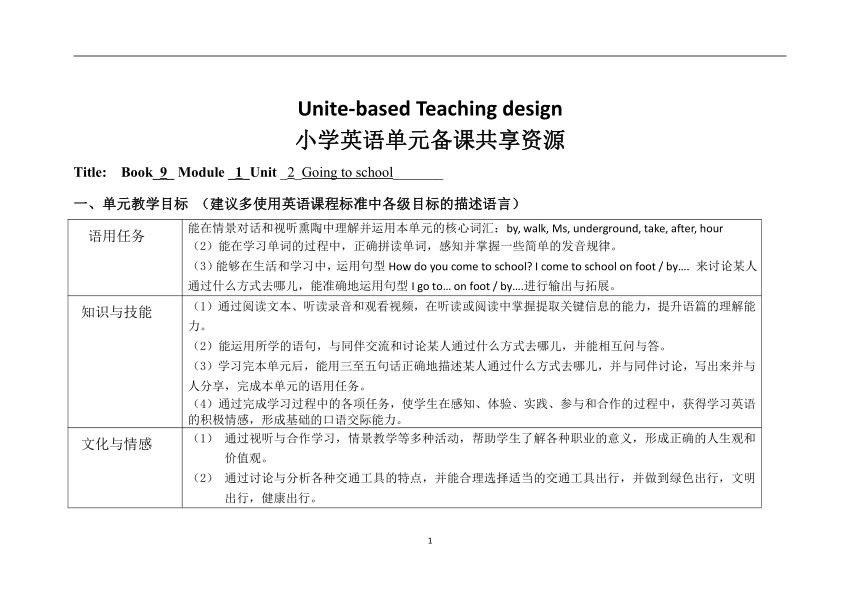 | |
| 格式 | zip | ||
| 文件大小 | 408.3KB | ||
| 资源类型 | 教案 | ||
| 版本资源 | 牛津深圳版 | ||
| 科目 | 英语 | ||
| 更新时间 | 2018-08-16 13:43:53 | ||
图片预览

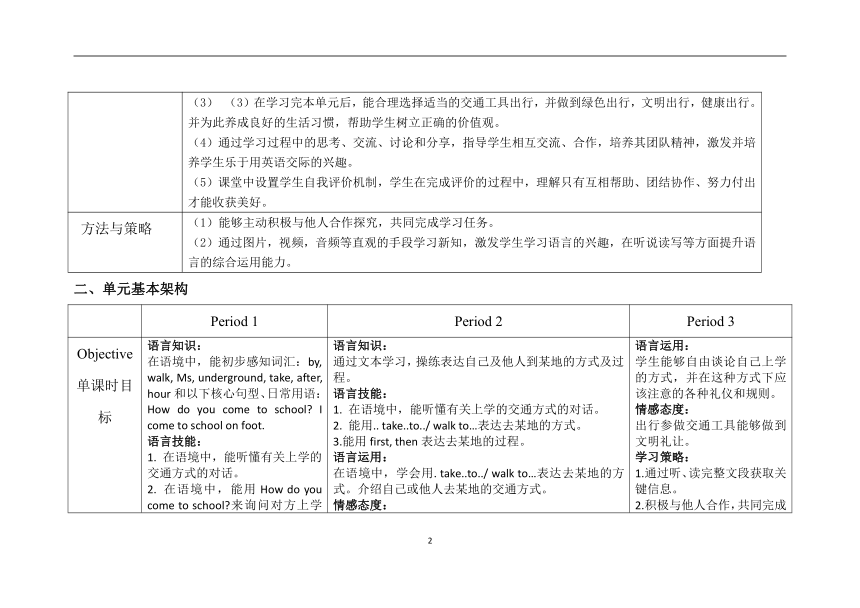
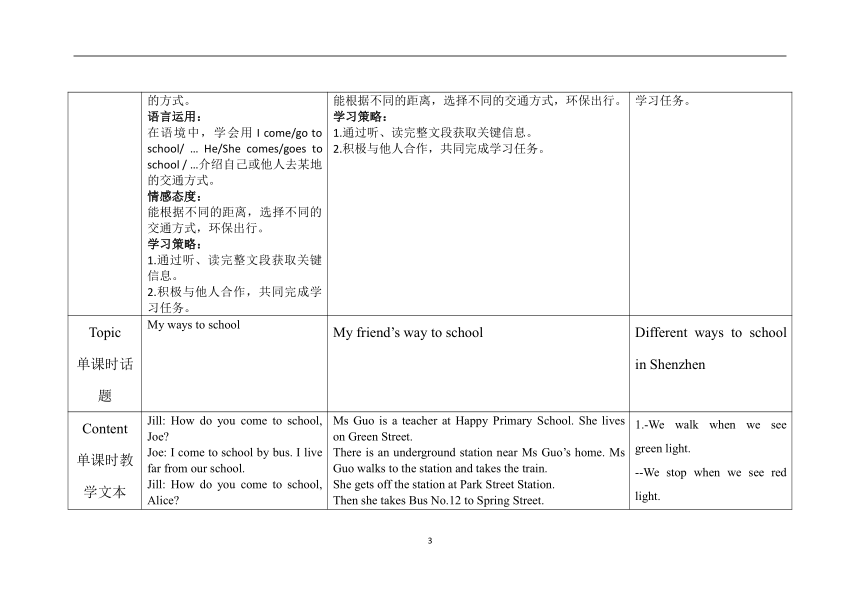
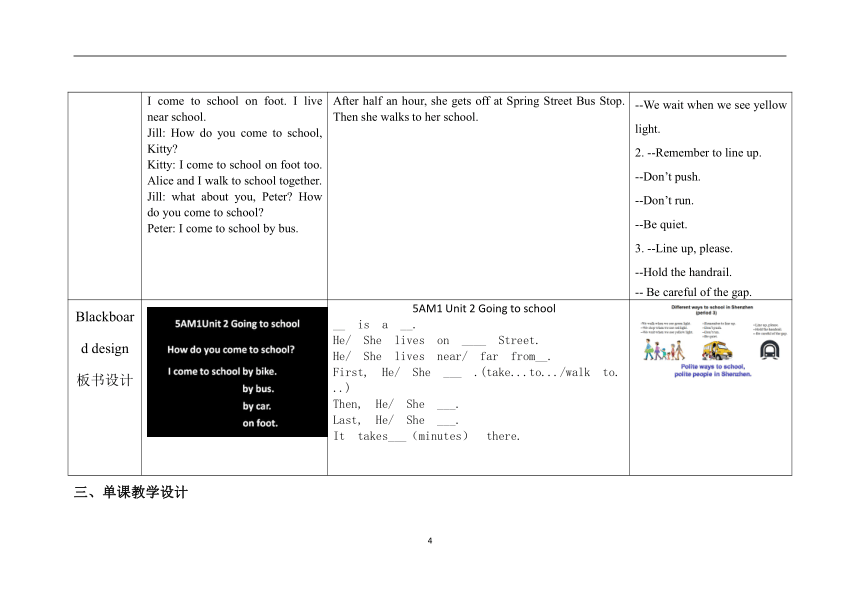
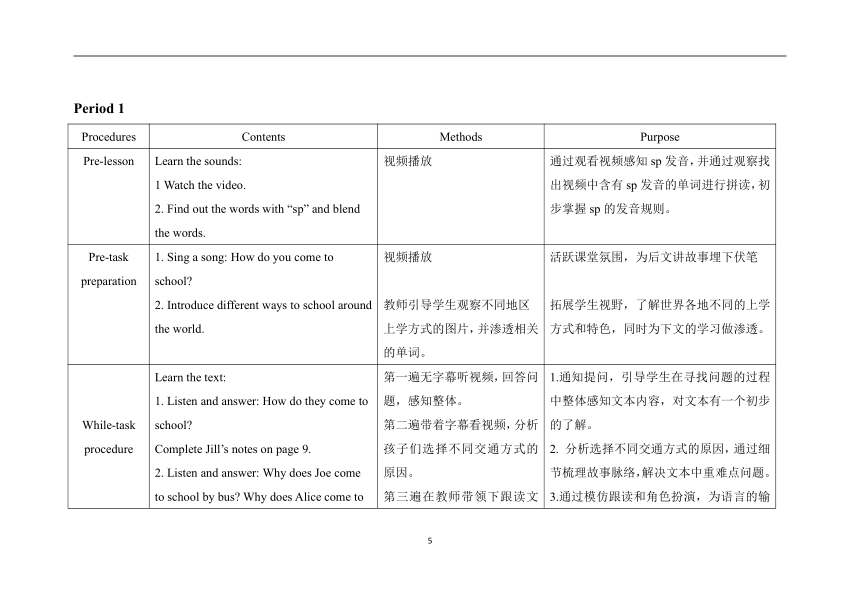
文档简介
Unite-based Teaching design
小学英语单元备课共享资源
Title: Book_9_ Module _1_Unit _2_Going to school_______
一、单元教学目标 (建议多使用英语课程标准中各级目标的描述语言)
语用任务
能在情景对话和视听熏陶中理解并运用本单元的核心词汇:by, walk, Ms, underground, take, after, hour
(2)能在学习单词的过程中,正确拼读单词,感知并掌握一些简单的发音规律。
(3)能够在生活和学习中,运用句型How do you come to school? I come to school on foot / by…. 来讨论某人通过什么方式去哪儿,能准确地运用句型I go to… on foot / by….进行输出与拓展。
知识与技能
(1)通过阅读文本、听读录音和观看视频,在听读或阅读中掌握提取关键信息的能力,提升语篇的理解能力。
(2)能运用所学的语句,与同伴交流和讨论某人通过什么方式去哪儿,并能相互问与答。
(3)学习完本单元后,能用三至五句话正确地描述某人通过什么方式去哪儿,并与同伴讨论,写出来并与人分享,完成本单元的语用任务。
(4)通过完成学习过程中的各项任务,使学生在感知、体验、实践、参与和合作的过程中,获得学习英语的积极情感,形成基础的口语交际能力。
文化与情感
通过视听与合作学习,情景教学等多种活动,帮助学生了解各种职业的意义,形成正确的人生观和价值观。
通过讨论与分析各种交通工具的特点,并能合理选择适当的交通工具出行,并做到绿色出行,文明出行,健康出行。
(3)在学习完本单元后,能合理选择适当的交通工具出行,并做到绿色出行,文明出行,健康出行。
并为此养成良好的生活习惯,帮助学生树立正确的价值观。
(4)通过学习过程中的思考、交流、讨论和分享,指导学生相互交流、合作,培养其团队精神,激发并培养学生乐于用英语交际的兴趣。
(5)课堂中设置学生自我评价机制,学生在完成评价的过程中,理解只有互相帮助、团结协作、努力付出才能收获美好。
方法与策略
(1)能够主动积极与他人合作探究,共同完成学习任务。
(2)通过图片,视频,音频等直观的手段学习新知,激发学生学习语言的兴趣,在听说读写等方面提升语言的综合运用能力。
二、单元基本架构
Period 1
Period 2
Period 3
Objective
单课时目标
语言知识:
在语境中,能初步感知词汇:by, walk, Ms, underground, take, after, hour和以下核心句型、日常用语:How do you come to school? I come to school on foot.
语言技能:
1. 在语境中,能听懂有关上学的交通方式的对话。
2. 在语境中,能用How do you come to school?来询问对方上学的方式。
语言运用:
在语境中,学会用I come/go to school/ … He/She comes/goes to school / …介绍自己或他人去某地的交通方式。
情感态度:
能根据不同的距离,选择不同的交通方式,环保出行。
学习策略:
1.通过听、读完整文段获取关键信息。
2.积极与他人合作,共同完成学习任务。
语言知识:
通过文本学习,操练表达自己及他人到某地的方式及过程。
语言技能:
1. 在语境中,能听懂有关上学的交通方式的对话。
2. 能用.. take..to../ walk to…表达去某地的方式。
3.能用first, then表达去某地的过程。
语言运用:
在语境中,学会用. take..to../ walk to…表达去某地的方式。介绍自己或他人去某地的交通方式。
情感态度:
能根据不同的距离,选择不同的交通方式,环保出行。
学习策略:
1.通过听、读完整文段获取关键信息。
2.积极与他人合作,共同完成学习任务。
语言运用:
学生能够自由谈论自己上学的方式,并在这种方式下应该注意的各种礼仪和规则。
情感态度:
出行参做交通工具能够做到文明礼让。
学习策略:
1.通过听、读完整文段获取关键信息。
2.积极与他人合作,共同完成学习任务。
Topic
单课时话题
My ways to school
My friend’s way to school
Different ways to school in Shenzhen
Content
单课时教学文本
Jill: How do you come to school, Joe?
Joe: I come to school by bus. I live far from our school.
Jill: How do you come to school, Alice?
I come to school on foot. I live near school.
Jill: How do you come to school, Kitty?
Kitty: I come to school on foot too. Alice and I walk to school together.
Jill: what about you, Peter? How do you come to school?
Peter: I come to school by bus.
Ms Guo is a teacher at Happy Primary School. She lives on Green Street.
There is an underground station near Ms Guo’s home. Ms Guo walks to the station and takes the train.
She gets off the station at Park Street Station.
Then she takes Bus No.12 to Spring Street.
After half an hour, she gets off at Spring Street Bus Stop. Then she walks to her school.
1.-We walk when we see green light.
--We stop when we see red light.
--We wait when we see yellow light.
2. --Remember to line up.
--Don’t push.
--Don’t run.
--Be quiet.
3. --Line up, please.
--Hold the handrail.
-- Be careful of the gap.
Blackboard design
板书设计
5AM1 Unit 2 Going to school
__?is?a?__.
He/?She?lives?on?____?Street.
He/?She?lives?near/?far?from__.
First,?He/?She?___?.(take...to.../walk?to...)
Then,?He/?She?___.
Last,?He/?She?___.
It?takes___(minutes)?there.
三、单课教学设计
Period 1
Procedures
Contents
Methods
Purpose
Pre-lesson
Learn the sounds:
1 Watch the video.
2. Find out the words with “sp” and blend the words.
视频播放
通过观看视频感知sp发音,并通过观察找出视频中含有sp发音的单词进行拼读,初步掌握sp的发音规则。
Pre-task preparation
1. Sing a song: How do you come to school?
2. Introduce different ways to school around the world.
视频播放
教师引导学生观察不同地区上学方式的图片,并渗透相关的单词。
活跃课堂氛围,为后文讲故事埋下伏笔
拓展学生视野,了解世界各地不同的上学方式和特色,同时为下文的学习做渗透。
While-task procedure
Learn the text:
1. Listen and answer: How do they come to school?
Complete Jill’s notes on page 9.
2. Listen and answer: Why does Joe come to school by bus? Why does Alice come to school on foot?
3. Follow and read the text.
4. Role-play.
第一遍无字幕听视频,回答问题,感知整体。
第二遍带着字幕看视频,分析孩子们选择不同交通方式的原因。
第三遍在教师带领下跟读文章。
第四遍学生进行角色扮演。
1.通知提问,引导学生在寻找问题的过程中整体感知文本内容,对文本有一个初步的了解。
2. 分析选择不同交通方式的原因,通过细节梳理故事脉络,解决文本中重难点问题。
3.通过模仿跟读和角色扮演,为语言的输出做进一步巩固
Post-task activity
Do a survey: How do you come to school? Finish the table on page12
学生四人小组讨论,完成12页的表格
学生结合自己的生活实际,进行口语输出。
Assignment
1. Finish the survey on page 12
2. Read the text for 3 times.
Period 2
Procedures
Contents
Methods
Purpose
Pre-lesson
Learn the sound:
blend the words
learn the rhyme
follow and read the rhyme
视频播放
通过拼读小诗中含有sp的词,操练sp胡发音,达到掌握sp的发音规则的目的。
学习小诗,并理解其意思;跟读视频达到能准确发音,流畅朗读的水平。
Pre-task preparation
Free talk:
1.ask and answer: How do you come to school? How does…come to school?(according to the survey done last lesson)
根据上节课做的调查回答问题。
通过根据上节课做的调查进行问答操练进行复习,并加强动词第三人称单数+s的使用。
While-task procedure
Learn the text:
1.Listen and answer the questions: What does Ms Guo do? How many ways does she go to work?
2.Watch and answer the question: How does Ms Guo go to work?
First, Ms Guo takes underground , then Bus No.12, last, she walks to her school.
3.follow the dics
4.read in group and complete the map
第一遍:无字幕听视频,带着问题,整体感知。
第二遍:带着问题看视频(学习文本)弄清楚Ms Guo的上班方式,边学边整理其上班所乘坐交通工具以及次序。
学习使用first, then来描述做事的先后次序。
学习go to…by…
= take …to…;
学习underground 的另一种表达:metro
小组分角色朗读,并完成地图
提炼本文的提纲。
通过跟读文本,达到准确,流畅朗读本故事。
通过文本学习,提炼Ms Guo的上班方式及次序。学习表达自己到某地的方式及过程。
同时,为下面操练环节作铺垫。
Post-task activity
1.Teacher talks about his/ her ways to school (use the frame summed up before)
2.Ss talk about Joe’s and Amy’s ways to school
__ is a __.
He/ She lives on ____ Street.
He/ She lives near/ far from__.
First, He/ She ___ .
Then, He/ She ___
Last, He/ She ___
It takes___ there.
通过描述Joe和Alice的上学方式,操练表达某人到某地的方式及过程。
Assignment
Draw and say (P11) ,using the frame given before
Period 3
Procedures
Contents
Methods
Purpose
Pre-lesson
Letter combination “sp” learning.
1.Brainstorming: Ask the students to think more words that include “sp”.
2.Help the Ss divide all the words into two kinds, eg:
wasp, crisp…/spi, spy, spider…
Review “sp” letter combination learning in period 2. Help the Ss master the different two sounds of “sp”.
Pre-task preparation
Sing the song “How do you go to school” and review what Ss learnt in period 2
1.Sing the song in period 2 “How do you go to school”.
2.Teacher adapts the lyrics of the song with some new transportations. Ss sing the song according to the same tune.
3.Sum-up of different ways to school with mind-map by checking the Ss’ homework.
1.Set the tune of this lesson with familiar songs.
2.Help the Ss use what they learnt in period 2.
3.Check how the Ss learn with homework and lean into this lesson.
While-task procedure
Different ways to school/work in Shenzhen
1.Tina goes to school on foot. Learn the traffic rules when Ss walk.
--We walk when we see green light.
--We stop when we see red light.
--We wait when we see yellow light.
2.Bibby goes to school by bus. Learn the rules when Ss take a bus.
--Remember to line up.
--Don’t push.
--Don’t run.
--Be quiet.
Say ‘Take my seat, please.’ When we see old man.
3.Lisa goes to school by metro. Learn the rules when Ss take the metro.
--Line up, please.
--Hold the handrail.
-- Be careful of the gap.
Connecting what Ss learn with the Ss’ real life.
Post-task activity
More rules about different ways to school.
Group discussing: Talk about more rules about different ways to school.
Brain storm and discuss.
Assignment
Write a short article about rules of different ways to school.
Board writing
四、阅读素养评价
A
Hi,?I’m?Mike,?I’m?a?clever?student.?Usually,?I?go?to?school?on?foot.?Because?my?home?is?near?the?school.?Tom?is?my?good?
friend.?We?often?go?to?school?together.?My?father?is?a?doctor.?He?often?goes?to?work?by?car.?My?mother?is?a?teacher.?She?
often?goes?to?work?by?bus,?but?sometimes?by?bike.??On?weekends,?I?often?go?to?the?park?with?my?parents.?In?the?afternoon,?I?often?go?to?the?library?by?bike.?I?like?reading.?After?dinner,?I?like?watching?TV?with?my?family.?
(?????)?1.?How do I go to school?
A. by car B. by bus C. on foot
(?????)?2.?How does my father go to school?
A. by underground B. by car C. by bike
(?????)?3.?What does my mother do?
A. a teacher B. a doctor C. a cook
(?????)?4.?What do I often do on weekend afternoon?
A. I often go to the park.
B. I often go to the library.
C. I often watch TV.
(?????)?5.?How do I go to the library?
A. on foot B. by bike C. by car
B
There are trains to carry people, trains to carry animals or carry things. There are fast trains and slow ones. Some trains go through hills. In big cities, the streets are very busy. So you can find trains under the ground. They are called subway in America, they carry people quickly in and out of the city. Can a train run over water? Yes, it can , there are many bridges over the rivers. The trains can easily run over the water. But it is not easy to build the bridges. Today’s trains have dining rooms for people. You may eat something in them on the way if you are hungry. Trains are useful to us. Many children have model trains. With the model trains , they can build their own rails and enjoy the wonderful world of trains.
Read and guess:
In the sentence “There are fast trains and slow ones.” Ones refers to:
bridge B. river C. trains D. subways
There are all kinds of trains. Here “all kinds of trains” means______.
fast trains and slow trains
many different kinds of trains
trains to go through hills
trains to carry people
The trains carry people in and out of the big cities under the ground because_____ .
the streets are very busy
the cities are big
the trains have dining room
he cities are too small
If you are hungry, you may go to _____ of the train have something to eat when you are travelling by train.
Some rooms
some shops
the dining rooms
the station
It’s ____ for trains to run over the water but____ to build bridges.
easy; easy
easily; not easy
difficult; easily
Easy; difficult
C True or false.
People travel to work in different ways. Some people go to work on foot because the live near their work places. Some people go to work by bike because the live farther away, or they like riding bikes. They think it’s good for their health. Today more people have their own cars, so they go to work in their cars. In the south of China, many people even go to work by boat because water is around their house. Will people go to work by plane? I think so, if necessary.( 必要)
( )1. All people like go to work by bike.
( )2. Some people think it’s good to go to work by bike.
( )3.today more people drive to work.
( )4.in the north of Chin, many people go to work by boat.
( )5. The writer thinks some people will go to work by plane if necessary.
D根据以下的三种上学方式,你能按照其中的范文,写出其中的规则或者礼仪吗?
We have different ways to go to school in our city, Shenzhen. When we go to school in different ways, we have different rules to follow.
Some people go to school on foot. We must follow the rules on the road. When we see red lights, we stop. When we see yellow lights, we wait. When we see green lights, we stop.
Some people go to school by bus. _______________________________________________________________________
___________________________________________________________________________________________________
Some ________________________________________________________________________________________
___________________________________________________________________________________________________
设计要求:
1. 建议选取的阅读内容与单元主题、单课时话题相关,根据学生的特点,为不同层次的学生选择不同的阅读材料,鼓励选取故事、对话、诗歌等不同形式的阅读材料,避免因为阅读材料太难而降低学生学习英语的兴趣;
2. 建议老师参考国外原版阅读材料、绘本等资源,语篇语言尽可能地道;
3. 在提供阅读体验的同时注重阅读习惯的培养,建议老师对阅读能力的考查设计不同类型的题型,对阅读理解类型提供做题方法和技巧的指导。
五、推荐阅读
1. 老师给孩子们推荐与主题相关的阅读材料或者影视剧作品等;
2. 孩子可以根据自己的选择在课外阅读或观赏,不做硬性要求。
小学英语单元备课共享资源
Title: Book_9_ Module _1_Unit _2_Going to school_______
一、单元教学目标 (建议多使用英语课程标准中各级目标的描述语言)
语用任务
能在情景对话和视听熏陶中理解并运用本单元的核心词汇:by, walk, Ms, underground, take, after, hour
(2)能在学习单词的过程中,正确拼读单词,感知并掌握一些简单的发音规律。
(3)能够在生活和学习中,运用句型How do you come to school? I come to school on foot / by…. 来讨论某人通过什么方式去哪儿,能准确地运用句型I go to… on foot / by….进行输出与拓展。
知识与技能
(1)通过阅读文本、听读录音和观看视频,在听读或阅读中掌握提取关键信息的能力,提升语篇的理解能力。
(2)能运用所学的语句,与同伴交流和讨论某人通过什么方式去哪儿,并能相互问与答。
(3)学习完本单元后,能用三至五句话正确地描述某人通过什么方式去哪儿,并与同伴讨论,写出来并与人分享,完成本单元的语用任务。
(4)通过完成学习过程中的各项任务,使学生在感知、体验、实践、参与和合作的过程中,获得学习英语的积极情感,形成基础的口语交际能力。
文化与情感
通过视听与合作学习,情景教学等多种活动,帮助学生了解各种职业的意义,形成正确的人生观和价值观。
通过讨论与分析各种交通工具的特点,并能合理选择适当的交通工具出行,并做到绿色出行,文明出行,健康出行。
(3)在学习完本单元后,能合理选择适当的交通工具出行,并做到绿色出行,文明出行,健康出行。
并为此养成良好的生活习惯,帮助学生树立正确的价值观。
(4)通过学习过程中的思考、交流、讨论和分享,指导学生相互交流、合作,培养其团队精神,激发并培养学生乐于用英语交际的兴趣。
(5)课堂中设置学生自我评价机制,学生在完成评价的过程中,理解只有互相帮助、团结协作、努力付出才能收获美好。
方法与策略
(1)能够主动积极与他人合作探究,共同完成学习任务。
(2)通过图片,视频,音频等直观的手段学习新知,激发学生学习语言的兴趣,在听说读写等方面提升语言的综合运用能力。
二、单元基本架构
Period 1
Period 2
Period 3
Objective
单课时目标
语言知识:
在语境中,能初步感知词汇:by, walk, Ms, underground, take, after, hour和以下核心句型、日常用语:How do you come to school? I come to school on foot.
语言技能:
1. 在语境中,能听懂有关上学的交通方式的对话。
2. 在语境中,能用How do you come to school?来询问对方上学的方式。
语言运用:
在语境中,学会用I come/go to school/ … He/She comes/goes to school / …介绍自己或他人去某地的交通方式。
情感态度:
能根据不同的距离,选择不同的交通方式,环保出行。
学习策略:
1.通过听、读完整文段获取关键信息。
2.积极与他人合作,共同完成学习任务。
语言知识:
通过文本学习,操练表达自己及他人到某地的方式及过程。
语言技能:
1. 在语境中,能听懂有关上学的交通方式的对话。
2. 能用.. take..to../ walk to…表达去某地的方式。
3.能用first, then表达去某地的过程。
语言运用:
在语境中,学会用. take..to../ walk to…表达去某地的方式。介绍自己或他人去某地的交通方式。
情感态度:
能根据不同的距离,选择不同的交通方式,环保出行。
学习策略:
1.通过听、读完整文段获取关键信息。
2.积极与他人合作,共同完成学习任务。
语言运用:
学生能够自由谈论自己上学的方式,并在这种方式下应该注意的各种礼仪和规则。
情感态度:
出行参做交通工具能够做到文明礼让。
学习策略:
1.通过听、读完整文段获取关键信息。
2.积极与他人合作,共同完成学习任务。
Topic
单课时话题
My ways to school
My friend’s way to school
Different ways to school in Shenzhen
Content
单课时教学文本
Jill: How do you come to school, Joe?
Joe: I come to school by bus. I live far from our school.
Jill: How do you come to school, Alice?
I come to school on foot. I live near school.
Jill: How do you come to school, Kitty?
Kitty: I come to school on foot too. Alice and I walk to school together.
Jill: what about you, Peter? How do you come to school?
Peter: I come to school by bus.
Ms Guo is a teacher at Happy Primary School. She lives on Green Street.
There is an underground station near Ms Guo’s home. Ms Guo walks to the station and takes the train.
She gets off the station at Park Street Station.
Then she takes Bus No.12 to Spring Street.
After half an hour, she gets off at Spring Street Bus Stop. Then she walks to her school.
1.-We walk when we see green light.
--We stop when we see red light.
--We wait when we see yellow light.
2. --Remember to line up.
--Don’t push.
--Don’t run.
--Be quiet.
3. --Line up, please.
--Hold the handrail.
-- Be careful of the gap.
Blackboard design
板书设计
5AM1 Unit 2 Going to school
__?is?a?__.
He/?She?lives?on?____?Street.
He/?She?lives?near/?far?from__.
First,?He/?She?___?.(take...to.../walk?to...)
Then,?He/?She?___.
Last,?He/?She?___.
It?takes___(minutes)?there.
三、单课教学设计
Period 1
Procedures
Contents
Methods
Purpose
Pre-lesson
Learn the sounds:
1 Watch the video.
2. Find out the words with “sp” and blend the words.
视频播放
通过观看视频感知sp发音,并通过观察找出视频中含有sp发音的单词进行拼读,初步掌握sp的发音规则。
Pre-task preparation
1. Sing a song: How do you come to school?
2. Introduce different ways to school around the world.
视频播放
教师引导学生观察不同地区上学方式的图片,并渗透相关的单词。
活跃课堂氛围,为后文讲故事埋下伏笔
拓展学生视野,了解世界各地不同的上学方式和特色,同时为下文的学习做渗透。
While-task procedure
Learn the text:
1. Listen and answer: How do they come to school?
Complete Jill’s notes on page 9.
2. Listen and answer: Why does Joe come to school by bus? Why does Alice come to school on foot?
3. Follow and read the text.
4. Role-play.
第一遍无字幕听视频,回答问题,感知整体。
第二遍带着字幕看视频,分析孩子们选择不同交通方式的原因。
第三遍在教师带领下跟读文章。
第四遍学生进行角色扮演。
1.通知提问,引导学生在寻找问题的过程中整体感知文本内容,对文本有一个初步的了解。
2. 分析选择不同交通方式的原因,通过细节梳理故事脉络,解决文本中重难点问题。
3.通过模仿跟读和角色扮演,为语言的输出做进一步巩固
Post-task activity
Do a survey: How do you come to school? Finish the table on page12
学生四人小组讨论,完成12页的表格
学生结合自己的生活实际,进行口语输出。
Assignment
1. Finish the survey on page 12
2. Read the text for 3 times.
Period 2
Procedures
Contents
Methods
Purpose
Pre-lesson
Learn the sound:
blend the words
learn the rhyme
follow and read the rhyme
视频播放
通过拼读小诗中含有sp的词,操练sp胡发音,达到掌握sp的发音规则的目的。
学习小诗,并理解其意思;跟读视频达到能准确发音,流畅朗读的水平。
Pre-task preparation
Free talk:
1.ask and answer: How do you come to school? How does…come to school?(according to the survey done last lesson)
根据上节课做的调查回答问题。
通过根据上节课做的调查进行问答操练进行复习,并加强动词第三人称单数+s的使用。
While-task procedure
Learn the text:
1.Listen and answer the questions: What does Ms Guo do? How many ways does she go to work?
2.Watch and answer the question: How does Ms Guo go to work?
First, Ms Guo takes underground , then Bus No.12, last, she walks to her school.
3.follow the dics
4.read in group and complete the map
第一遍:无字幕听视频,带着问题,整体感知。
第二遍:带着问题看视频(学习文本)弄清楚Ms Guo的上班方式,边学边整理其上班所乘坐交通工具以及次序。
学习使用first, then来描述做事的先后次序。
学习go to…by…
= take …to…;
学习underground 的另一种表达:metro
小组分角色朗读,并完成地图
提炼本文的提纲。
通过跟读文本,达到准确,流畅朗读本故事。
通过文本学习,提炼Ms Guo的上班方式及次序。学习表达自己到某地的方式及过程。
同时,为下面操练环节作铺垫。
Post-task activity
1.Teacher talks about his/ her ways to school (use the frame summed up before)
2.Ss talk about Joe’s and Amy’s ways to school
__ is a __.
He/ She lives on ____ Street.
He/ She lives near/ far from__.
First, He/ She ___ .
Then, He/ She ___
Last, He/ She ___
It takes___ there.
通过描述Joe和Alice的上学方式,操练表达某人到某地的方式及过程。
Assignment
Draw and say (P11) ,using the frame given before
Period 3
Procedures
Contents
Methods
Purpose
Pre-lesson
Letter combination “sp” learning.
1.Brainstorming: Ask the students to think more words that include “sp”.
2.Help the Ss divide all the words into two kinds, eg:
wasp, crisp…/spi, spy, spider…
Review “sp” letter combination learning in period 2. Help the Ss master the different two sounds of “sp”.
Pre-task preparation
Sing the song “How do you go to school” and review what Ss learnt in period 2
1.Sing the song in period 2 “How do you go to school”.
2.Teacher adapts the lyrics of the song with some new transportations. Ss sing the song according to the same tune.
3.Sum-up of different ways to school with mind-map by checking the Ss’ homework.
1.Set the tune of this lesson with familiar songs.
2.Help the Ss use what they learnt in period 2.
3.Check how the Ss learn with homework and lean into this lesson.
While-task procedure
Different ways to school/work in Shenzhen
1.Tina goes to school on foot. Learn the traffic rules when Ss walk.
--We walk when we see green light.
--We stop when we see red light.
--We wait when we see yellow light.
2.Bibby goes to school by bus. Learn the rules when Ss take a bus.
--Remember to line up.
--Don’t push.
--Don’t run.
--Be quiet.
Say ‘Take my seat, please.’ When we see old man.
3.Lisa goes to school by metro. Learn the rules when Ss take the metro.
--Line up, please.
--Hold the handrail.
-- Be careful of the gap.
Connecting what Ss learn with the Ss’ real life.
Post-task activity
More rules about different ways to school.
Group discussing: Talk about more rules about different ways to school.
Brain storm and discuss.
Assignment
Write a short article about rules of different ways to school.
Board writing
四、阅读素养评价
A
Hi,?I’m?Mike,?I’m?a?clever?student.?Usually,?I?go?to?school?on?foot.?Because?my?home?is?near?the?school.?Tom?is?my?good?
friend.?We?often?go?to?school?together.?My?father?is?a?doctor.?He?often?goes?to?work?by?car.?My?mother?is?a?teacher.?She?
often?goes?to?work?by?bus,?but?sometimes?by?bike.??On?weekends,?I?often?go?to?the?park?with?my?parents.?In?the?afternoon,?I?often?go?to?the?library?by?bike.?I?like?reading.?After?dinner,?I?like?watching?TV?with?my?family.?
(?????)?1.?How do I go to school?
A. by car B. by bus C. on foot
(?????)?2.?How does my father go to school?
A. by underground B. by car C. by bike
(?????)?3.?What does my mother do?
A. a teacher B. a doctor C. a cook
(?????)?4.?What do I often do on weekend afternoon?
A. I often go to the park.
B. I often go to the library.
C. I often watch TV.
(?????)?5.?How do I go to the library?
A. on foot B. by bike C. by car
B
There are trains to carry people, trains to carry animals or carry things. There are fast trains and slow ones. Some trains go through hills. In big cities, the streets are very busy. So you can find trains under the ground. They are called subway in America, they carry people quickly in and out of the city. Can a train run over water? Yes, it can , there are many bridges over the rivers. The trains can easily run over the water. But it is not easy to build the bridges. Today’s trains have dining rooms for people. You may eat something in them on the way if you are hungry. Trains are useful to us. Many children have model trains. With the model trains , they can build their own rails and enjoy the wonderful world of trains.
Read and guess:
In the sentence “There are fast trains and slow ones.” Ones refers to:
bridge B. river C. trains D. subways
There are all kinds of trains. Here “all kinds of trains” means______.
fast trains and slow trains
many different kinds of trains
trains to go through hills
trains to carry people
The trains carry people in and out of the big cities under the ground because_____ .
the streets are very busy
the cities are big
the trains have dining room
he cities are too small
If you are hungry, you may go to _____ of the train have something to eat when you are travelling by train.
Some rooms
some shops
the dining rooms
the station
It’s ____ for trains to run over the water but____ to build bridges.
easy; easy
easily; not easy
difficult; easily
Easy; difficult
C True or false.
People travel to work in different ways. Some people go to work on foot because the live near their work places. Some people go to work by bike because the live farther away, or they like riding bikes. They think it’s good for their health. Today more people have their own cars, so they go to work in their cars. In the south of China, many people even go to work by boat because water is around their house. Will people go to work by plane? I think so, if necessary.( 必要)
( )1. All people like go to work by bike.
( )2. Some people think it’s good to go to work by bike.
( )3.today more people drive to work.
( )4.in the north of Chin, many people go to work by boat.
( )5. The writer thinks some people will go to work by plane if necessary.
D根据以下的三种上学方式,你能按照其中的范文,写出其中的规则或者礼仪吗?
We have different ways to go to school in our city, Shenzhen. When we go to school in different ways, we have different rules to follow.
Some people go to school on foot. We must follow the rules on the road. When we see red lights, we stop. When we see yellow lights, we wait. When we see green lights, we stop.
Some people go to school by bus. _______________________________________________________________________
___________________________________________________________________________________________________
Some ________________________________________________________________________________________
___________________________________________________________________________________________________
设计要求:
1. 建议选取的阅读内容与单元主题、单课时话题相关,根据学生的特点,为不同层次的学生选择不同的阅读材料,鼓励选取故事、对话、诗歌等不同形式的阅读材料,避免因为阅读材料太难而降低学生学习英语的兴趣;
2. 建议老师参考国外原版阅读材料、绘本等资源,语篇语言尽可能地道;
3. 在提供阅读体验的同时注重阅读习惯的培养,建议老师对阅读能力的考查设计不同类型的题型,对阅读理解类型提供做题方法和技巧的指导。
五、推荐阅读
1. 老师给孩子们推荐与主题相关的阅读材料或者影视剧作品等;
2. 孩子可以根据自己的选择在课外阅读或观赏,不做硬性要求。
同课章节目录
- Module 1 Getting to know each othe
- Unit 1 My future
- Unit 2 Going to school
- Unit 3 My birthday
- Revision 1
- Project 1
- Module 2 Relationships
- Unit 4 Grandparents
- Unit 5 Friends
- Unit 6 Family life
- Revision 2
- Project 2
- Module 3 Out and about
- Unit 7 At the beach
- Unit 8 An outing
- Unit 9 Around the city
- Revision 3
- Project 3
- Module 4 The natural world
- Unit 10 Wind
- Unit 11 Wate
- Unit 12 Fire
- Revision 4
- Project 4
